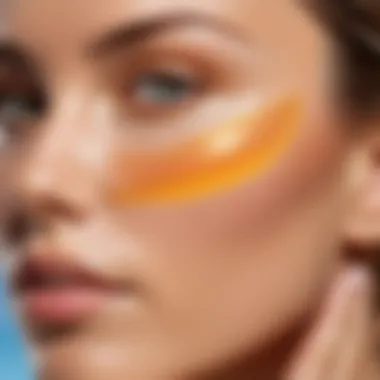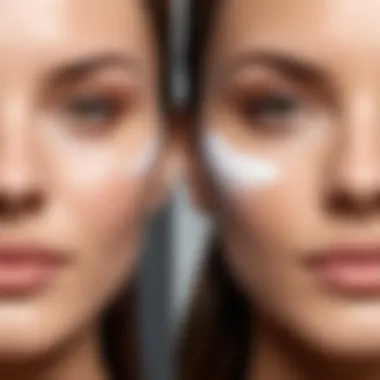Understanding SPF: Importance and Practical Insights


Intro
In the modern world, where the sun's rays can both invigorate and harm, understanding SPF becomes essential. SPF, or Sun Protection Factor, plays a pivotal role in how we shield our skin from the sun's detrimental effects. Educating ourselves about its significance can make the difference between healthy, glowing skin and the repercussions of sun damage.
The Significance of SPF in Skincare
When one mentions SPF, many people primarily think of beach days or sunny picnics, but the truth runs deeper. SPF is not merely a seasonal product; it's a year-round necessity. From daily commutes to outdoor activities, UV rays lurk everywhere. These rays can lead to skin issues like premature aging, sunburn, and even skin cancer. Thus, incorporating a proper SPF into daily skincare routines is crucial.
What does SPF really mean? At its core, SPF indicates the level of protection a sunscreen offers against UVB rays, which are responsible for sunburn and can contribute to the development of skin cancer. Still, it’s a common misconception that higher SPF numbers correlate to linear increases in protection. For example, SPF 30 blocks approximately 97% of UVB rays, while SPF 50 blocks about 98%. Therefore, higher isn’t always better when it comes to sun protection.
Misconceptions about SPF
Aside from the numerical confusion, several myths surround the usage of SPF.
- "I don’t need sunscreen on cloudy days." Many underestimate that up to 80% of UV rays can penetrate clouds.
- "I only need to apply it once a day." Sunscreen must be reapplied every two hours, especially after swimming or sweating.
- "Dark skin doesn’t need sunscreen." This misconception can lead to serious skin damage across all skin types.
These fallacies illustrate the need for a more nuanced understanding of SPF in our skincare routines.
Navigating SPF Products
Identifying the right product can seem like navigating a minefield.
When selecting an SPF product, consider the following:
- Broad Spectrum Protection - This ensures you are protected against both UVA and UVB rays.
- Skin Type - For oily or acne-prone skin, gel-based sunscreens work best. Those with dry skin may opt for cream-based options.
- Environmental Factors - If you're engaging in outdoor activities or swimming, look for water-resistant formulations.
"Using SPF isn't just about preventing burns; it’s about preserving skin health in the long haul."
Best Practices for Application
How to effectively use SPF is just as vital as what product you choose. Here’s a compact guideline:
- Apply generously: Most people don’t use enough. Aim for about a shot glass full for full-body applications.
- Timing is key: Apply 15 minutes before sun exposure for optimal effectiveness.
- Blend well: Ensure even coverage, as missed spots can result in burns.
By taking these steps seriously, individuals can safeguard their skin and enhance its resilience against daily sun exposure.
What is SPF?
Understanding what SPF is crucial as it serves as a fundamental pillar in sunscreen and skincare discussions. SPF, or Sun Protection Factor, acts as a measure of how well a product can protect your skin from the sun's harmful rays. It is not merely a number slapped on a bottle – it represents a significant consideration for maintaining skin health and preventing long-term damage such as premature aging and skin cancer. As we explore this topic, we’ll delve into the specific aspects that render SPF a vital component in skincare routines.
Definition of SPF
At its core, SPF indicates the level of protection a sunscreen provides against UVB rays, which cause sunburn and can lead to detrimental skin conditions. To put it simply, a sunscreen with an SPF rating of 30 allows you to stay in the sun 30 times longer without burning than if you weren't wearing any sunscreen at all. However, this doesn't mean you can ignore reapplication or that you are entirely shielded.
The formula looks something like this: If it normally takes you 10 minutes to start turning red without sunscreen, an SPF of 30 theoretically lets you stay under the sun for about 300 minutes (or 5 hours) before burning. But the reality is often messier, with factors like sweat, water, and time outdoors playing significant roles in effectiveness. Mistakes can happen, and misunderstanding SPF can lead to overconfidence, which in turn can increase the risk of skin issues later on.
SPF in Skincare
Incorporating SPF into your skincare regimen is more than just a summer season trend; it is a year-round necessity. Daily exposure to harmful UV rays occurs regardless of the weather. Clouds don’t block all UV rays; these rays can even penetrate glass. As such, applying a broad-spectrum sunscreen, which protects against both UVA and UVB rays, is highly recommended.
Among the benefits of SPF in skincare are:
- Prevention of sunburn: Use of SPF products minimizes immediate negative effects, such as redness and peeling skin.
- Long-term skin health: Regular use can stave off premature aging, characterized by wrinkles, fine lines, and liver spots.
- Reduced risk of skin cancer: Studies show that daily usage of SPF can considerably lower the risk of developing skin cancers, including melanoma.
It's noteworthy that the formulation of the SPF product can also matter significantly. Some individuals might find that chemical SPFs, which absorb UV rays, can feel lighter and less greasy than physical or mineral options, which often contain zinc oxide or titanium dioxide that sit more on the skin's surface.
The Science Behind SPF
Understanding the science behind SPF is crucial for anyone looking to protect their skin effectively. Grab a chair, as we dive into the nitty-gritty of how SPF works and the rays it shields you from. Knowing the fundamentals can make a world of difference in how you select and apply sun protection products. It's not just a matter of slapping on some lotion and calling it a day; the chemistry of sunlight and skin interaction is a topic that deserves close attention.
Understanding UV Rays
Ultraviolet (UV) rays are a part of the electromagnetic spectrum that our eyes can't see but are responsible for many skin concerns. There are two main types of UV rays that we need to be aware of: UVA and UVB.
- UVA rays: These rays are primarily associated with skin aging. They penetrate the skin more deeply and can cause long-term damage and aging signs like wrinkles and leathery skin. Think of it like a sneaky guest; they linger longer than you ever wanted.
- UVB rays: Contrarily, these are the culprits behind sunburn and play a significant role in developing skin cancer. They're the flashy party attendents that can quickly wreck your day if you're not careful.


Both types of rays can do a number on your skin over time, so understanding how SPF interacts with these UV rays forms the backbone of effective sun protection. Whether you're lounging by the pool or out for a jog in the park, being aware of this information can be a game-changer for protecting your skin.
How SPF Works
Now, let’s chat about how SPF, or Sun Protection Factor, actually gets the job done. The number you see on the label—like SPF 15 or SPF 30—indicates how long the product will protect your skin from UVB rays compared to if you weren’t wearing any at all. For example, an SPF 30 means you can theoretically stay in the sun 30 times longer without burning than if you had no protection.
When you apply sunscreen, it creates a barrier on your skin that absorbs or reflects UV rays. Here are a few important points about how it works:
- Chemical Sunscreens: These absorb UV rays and convert them into heat, which then releases from the skin. Ingredients like avobenzone and octocrylene are prime examples. They’re often lightweight and blend into the skin more easily.
- Physical Sunscreens: They sit on top of the skin and deflect UV rays. Zinc oxide and titanium dioxide are typical ingredients in this category. Think of them as a superhero outfit protecting your skin from incoming attacks.
Key Takeaways:
- The higher the SPF, the more protection you get from UVB rays—up to a point.
- No sunscreen blocks 100% of UV rays, so reapplication is key. Also, don’t forget your hats and UV-blocking shades. They’re not just for show!
"SPF only measures UVB protection; It's essential to choose broad-spectrum sunscreens for full protection against both UVA and UVB."
In summary, grasping the science of UV rays and SPF can empower you to take a more proactive role in your skincare. With this knowledge, the next time you're at the store, you won’t just be picking the most colorful bottle; you’ll be making an informed choice for your skin's health.
Types of SPF Products
Understanding the different types of SPF products is crucial for effective skin protection. Each product type has its unique formulation and method of action, leading to different benefits and considerations for users. Grasping these distinctions can make all the difference in creating a suitable skincare routine that properly shields your skin from harmful UV rays.
Chemical vs. Physical SPF
Chemical SPF products absorb UV radiation through their chemical ingredients, such as octisalate or avobenzone. These compounds transform UV rays into heat, which is released from the skin. This method tends to feel lighter on the skin, making it an attractive option for daily use. People often find that chemical sunscreens blend easily with various makeup products, providing a seamless finish.
Alternatively, physical SPF, composed of minerals like zinc oxide or titanium dioxide, reflects UV rays away from the skin. While they might leave a visible white tint, they’re often recommended for sensitive skin and can provide immediate protection upon application. Many folks praise the mineral versions for their natural formulation and reduced risk of skin irritation.
When to choose which:
- Everyday Use: Chemical SPF products are generally preferable for daily wear due to their lightweight feel.
- Sensitive Skin: If you’re prone to irritation or allergic reactions, physical options may be your best bet.
Broad Spectrum Products
Broad-spectrum SPF is a term that indicates a product protects against both UVA and UVB rays. Understanding this can be a game-changer for anyone interested in skincare. UVB rays are the primary culprits for sunburn, while UVA rays penetrate deeper, causing premature aging and a higher risk of skin cancer. A broad-spectrum protection system ensures you’re safeguarded against both types, eliminating the risk from gaps in coverage with lower-rated products.
Interestingly, many individuals assume that all SPFs protect against both types of rays, leading to some misconceptions. This misunderstanding can lead to inadequate protection, making it essential to actively look for broad-spectrum labels on products.
"Broad-spectrum sunscreen is not just an option; it’s a necessity for comprehensive safety against sun damage."
When selecting a broad-spectrum product, consider the SPF number as well. An SPF of 30 will shield about 97% of UVB rays, while SPF 50 can protect against approximately 98%. However, it’s essential to remember that no sunscreen can provide 100% protection.
It's necessary to align product choice with specific activities—such as swimming or sports—so that you can maintain effectiveness. In the long run, understanding these product nuances can help in crafting a well-rounded approach to your skincare regimen, ensuring that protection persists across various conditions, providing peace of mind on sunny days.
Choosing the Right SPF
When it comes to protecting your skin from harmful UV rays, choosing the right SPF isn't just a matter of picking whatever is on sale at the drugstore. It's a nuanced decision that can have lasting effects on skin health. Each individual's skin type, lifestyle, and even geographic location play a critical role in what SPF will best protect against damage and aging.
Skin Type Considerations
Understanding your skin type is the cornerstone of selecting an appropriate SPF. Different skin types—oily, dry, combination, and sensitive—react differently to sun exposure and products applied. For instance, individuals with oily skin might prefer a gel-based or matte-finish SPF that doesn't exacerbate oiliness, while those with dry skin should lean toward cream-based formulas that nourish and hydrate.
- Oily Skin: Look for products labeled as "oil-free" or "non-comedogenic." Gel sunscreens with SPF 30 or higher can shield your skin while keeping it matte.
- Dry Skin: Choose moisturizing sunscreens that contain ingredients like hyaluronic acid or glycerin to help retain moisture. Creams and lotions are preferred.
- Sensitive Skin: If you have skin that’s prone to irritation, opt for physical sunscreens with zinc oxide or titanium dioxide, as they are less likely to cause reactions.
Being aware of these factors not only aids you in choosing the right SPF product but also enhances your overall skin health amid sun exposure.
Daily vs. High Exposure Products
When considering SPF, it is crucial to differentiate between daily-use and high-exposure products. Daily-use sunscreen is formulated for everyday wear and may have lighter textures and lower SPF ratings, usually starting around SPF 15 to 30. This is more than adequate for the average office-goer or someone who spends limited time outdoors. A good daily-use sunblock may feel more like a moisturizer and absorb quickly, making it user-friendly.
In contrast, high exposure products are designed for individuals who spend prolonged time in the sun—think beach days, hiking, or outdoor sports. These formulations tend to be water-resistant and have elevated SPF ratings, often above SPF 30. Here, you would also prefer a thicker cream or spray, as they provide a more robust barrier against UV rays. Be mindful that high exposure doesn’t mean you can skip reapplication; it's typically recommended to reapply every two hours, or immediately after sweating or swimming.
"Choosing the appropriate SPF based on activity levels and skin type can make a massive difference in maintaining healthy skin."
In summary, whether you’re selecting a daily SPF or gearing up for a day in the sun, ensure your choice aligns with skin type and expected sun exposure. Being informed will not only enhance your protective measures but also keep your skin looking its best regardless of the elements around you.


Application Guidelines
When it comes to SPF, the application guidelines can make all the difference in safeguarding your skin from harmful UV rays. Following the right practices not only maximizes protection but also enhances the overall effectiveness of the product. Too often, people apply sunscreen as an afterthought or in insufficient quantities, resulting in less than optimal outcomes. Proper application ensures that the product adheres well to the skin and offers the protection advertised on the label.
How Much SPF to Use
It’s essential to apply an adequate amount of sunscreen to ensure that it works as intended. A general rule of thumb is to use about one ounce, which is roughly the amount that would fill a shot glass, for full-body coverage. This quantity is crucial because, if you use less, you’re essentially reducing the SPF potency. When applying, don’t forget areas like the ears, back of the hands, and even your scalp if you have thinning hair, as these spots are often neglected but quite vulnerable to sun damage.
Another key consideration is the SPF number itself. Higher SPF numbers do offer more protection but often give a false sense of security. Sticking to an SPF of 30 is usually recommended for daily use, as it blocks around 97% of UVB rays. Applying it thickly and evenly can improve your shield against the sun. Remember, it’s not just about having the product; it’s about the right application method.
Reapplication Techniques
Reapplication is another critical aspect of using SPF effectively. No matter how robust the SPF you apply, its efficacy diminishes over time due to various factors such as sweating, swimming, and even towel drying off. To maintain consistent protection, it’s crucial to reapply every two hours, or immediately after engaging in activities that could remove it.
Here are a few tips for effective reapplication:
- Use a Timer: Set a timer on your phone to remind you to reapply. It’s easy to get caught up in outdoor activities and forget this step.
- Patting Instead of Rubbing: When reapplying, consider patting it onto the skin rather than rubbing it in. This technique prevents disturbing the existing layer of sunscreen.
- Opt for Sprays or Powders: For convenience, using SPF sprays or powders can ease the reapplication process, especially when you’re outdoor. They can be applied over makeup, allowing for seamless protection while maintaining your look.
"Sunscreen is like a security guard for your skin, always ready to defend against unexpected sun exposure. Don't skimp on its service time!"
Understanding how much SPF to use and effectively reapplying it can transform your skincare routine. Not only do these guidelines ensure a significant reduction in the risk of sun damage, but they also empower you to enjoy life outdoors while keeping your skin protected.
Common Misconceptions About SPF
When it comes to SPF, confusion seems to reign supreme among many individuals. Understanding these misconceptions is key not only for optimizing skin protection but also for fostering a culture of informed skincare. Misunderstandings about SPF can lead to inadequate application, overconfidence in sun exposure, and ultimately, skin damage. Being well-informed is an essential weapon in the fight against harmful UV rays, and dispelling these myths is a step in the right direction.
SPF Does Not Eliminate Tanning
One of the most persistent myths is the belief that using a high SPF will completely prevent tanning. While SPF products are designed to protect your skin from the damaging rays of the sun, they do not provide a magical shield. The reality is that even with the right SPF, some degree of UV exposure is inevitable.
- What SPF Protects Against: SPF primarily prevents UVB rays, which are responsible for sunburn and can potentially contribute to skin cancer. However, it does not block UVA rays effectively, and these can cause skin aging and tanning.
- Tanning as a Skin Response: The appearance of a tan is your skin's natural way of protecting itself against UV exposure. When it senses higher UV levels, it produces more melanin—resulting in a darker skin tone. Thus, using SPF may slow this process, but won’t stop it completely.
- The Takeaway: You can still tan even while being diligent with your SPF application, so adjusting your expectations is important. Additionally, it serves to reinforce the idea that all skin types can be susceptible to damage, and maintaining awareness of how SPF works is vital for effective skincare.
Water-Resistant Myths
Another common misunderstanding revolves around the term "water-resistant" on SPF products. Many people equate water-resistant with being waterproof, which is far from accurate. Understanding this subtlety can save individuals from unexpected skin woes after a day in the sun.
- What Does Water-Resistant Really Mean? The FDA defines water-resistant SPF as a product that will maintain its SPF protection for up to 40 or 80 minutes when you’re sweating or submerged in water. It doesn’t last indefinitely, which can be misleading for consumers who might think they are fully protected for hours on end.
- Importance of Reapplication: Just because a product is labeled water-resistant doesn’t mean you can forget about it while at the beach or in the pool. Regular reapplication is still crucial after swimming or heavy sweating, regardless of water resistance.
- Conclusion: It's a smart practice to read labels and understand the specifics of any product before relying solely on its claims. This understanding not only enhances sun safety but also encourages a proactive skincare approach.
"Knowing the truth about SPF can be your best ally in maintaining both health and appearance."
Regulations and Standards of SPF
Regulations and standards governing SPF products play a crucial role in ensuring consumer safety and product efficacy. On the face of it, these regulations might seem like mere bureaucratic measures, but they help establish a baseline of quality and effectiveness. All the fine print matters, especially when it comes to protecting our skin. Without these guidelines, consumers could easily get lost in a sea of marketing claims that may promote products without substantive backing. This section seeks to flesh out the significance of both FDA regulations and international standards, looking into how they shape what we use daily.
FDA Regulations
In the United States, the Food and Drug Administration (FDA) sets forth rigorous guidelines that manufacturers must adhere to when they market SPF products. These regulations, like a stern parent keeping a watchful eye, ensure that what is labeled on the bottle is precisely what the consumer will receive.
- Labeling Requirements: The FDA demands that all products clearly indicate their SPF value, which relates to how long a person can theoretically stay in the sun without burning compared to wearing no sunscreen at all. For example, if a person normally burns after 10 minutes of sun exposure, an SPF 30 sunscreen would allow for 300 minutes of protection under ideal conditions, although real-world factors complicate this.
- Testing Protocols: Companies must conduct standardized testing processes to substantiate their claims. Test results must reflect actual product performance to prevent misleading advertisements. This helps consumers in making informed decisions, putting a layer of accountability on manufacturers.
- Marketing and Claims: The FDA is also particular about what can be claimed on the product’s packaging. Terms like "waterproof" or "sunblock" can’t be used without rigorous proof. Instead, labels must use terminology like "water-resistant" and clearly indicate how long the protection lasts under specific conditions.
"The SPF number alone doesn't determine the effectiveness of a sunscreen; how it's applied and how often it’s reapplied equally matter."
International Standards
The global market necessitates a level of standardization when it comes to SPF products. Different countries have varying regulations, but many adhere to guidelines set by international bodies, such as the International Organization for Standardization (ISO). These guidelines foster a shared understanding of SPF efficacy worldwide.
- ISO Standards: The ISO has established test methods for determining how well a sunscreen protects against UV radiation. Most notably, these methods ensure that products are tested for broad-spectrum protection, meaning they shield both UVA and UVB rays. This collective effort towards standardization enables users to compare products between brands and countries.
- Regional Compliance: For many brands, especially those that cross borders, keeping up with regulations in different regions can be a juggling act. For instance, the European Union has different testing standards compared to the United States, impacting product formulation and labeling. This means that a sunscreen approved in one market may not necessarily meet the criteria in another.
- Consumer Awareness: As consumers become more savvy about ingredient safety and SPF efficacy, they are driving companies to raise the bar. An informed public is powerful; it can compel even the most established brands to comply with stricter standards and enhance product innovation.
Impact of Environment on SPF Effectiveness
Understanding how the environment affects SPF effectiveness is crucial for anyone who is serious about their skincare routine. Environmental factors do not merely influence the intensity of UV rays; they can also impact how well your sun protection measures hold up. A little forethought can go a long way in safeguarding your skin, so let’s break this down.
Humidity and Temperature
Humidity and temperature can significantly dictate SPF effectiveness. In warmer, humid climates, the perspiration rate increases, possibly leading to the breakdown of products that don't withstand moisture well. A sweat-drenched application diminishes the protective layer you relied upon when slathering on that SPF thirty minutes prior. For many sunscreens, especially those with a water-resistant label, the efficacy depends on how well they adhere to the skin. High humidity can cause sunscreens to slide off or get diluted, thereby losing their protective quality.


In addition, extreme temperatures can lead to changes in the formulation of sunscreen products. For instance, creams or lotions stored in hot conditions may separate, rendering them less effective. On the flip side, cold weather doesn’t increase sun damage directly but can lead to skin dryness. Dry skin often requires more hydration, and this is a critical point; a dry layer can make sunscreen applications patchy.
To optimize your sun protection in these conditions, consider applying products labeled as ‘water-resistant’ or ‘sweat-proof’, especially if you're outdoors for extended periods. Layering may also help. Apply a lightweight serum specifically for oil control, followed by your SPF. This practice can create a more stable base for product adherence.
Remember: It’s essential to reapply every two hours, or more often if sweating heavily.
Altitude and UV Exposure
Altitude has a profound effect on UV exposure levels. Simply put, the higher you go, the thinner the air gets. The atmosphere at elevation filters fewer UV rays, meaning you're more susceptible to sunburn even if it’s a cool day, or if you're just taking a short hike.
For instance, at an altitude of around 3,000 meters, UV radiation exposure can increase by about 30%. This is particularly relevant for hikers, skiers, or anyone involved in outdoor activities in mountainous regions. The UV index often spikes in these areas, which makes proper protection even more crucial.
Additionally, reflections can intensify exposure. Snow can reflect up to 80% of UV rays, significantly increasing the risk of skin damage. Water surfaces do the same, which is something to consider if you're hiking near lakes or spending time at resorts with pools.
When preparing for outdoor activities in high altitudes, choose a broad-spectrum sunscreen with a high SPF rating, preferably one that says it is water-resistant. Don’t forget to focus on often-missed areas, such as the ears, the back of the neck, and the tops of your feet.
In Summary: The effectiveness of SPF can be swayed by multiple environmental factors, including humidity and altitude. Understanding these elements can aid in your decision-making when it comes to sun protection and help you enjoy your outdoor experiences without the worry of skin damage.
SPF and Different Skin Types
When it comes to protecting our skin, understanding the interplay between SPF and our unique skin types is crucial. Not every face is the same, and just as individual as our complexions are, so too are our skincare needs. Factors like oiliness, sensitivity, and even skin tone can influence how SPF products perform, making it essential to tailor our choices accordingly. This section will dissect the relevant elements of SPF in relation to different skin types, outlining the benefits and considerations one should have in mind.
SPF for Oily Skin
SPF for oily skin is like hunting for a needle in a haystack—tricky, but definitely manageable with the right knowledge. Oily skin, often characterized by enlarged pores and a shiny complexion, can be a bit finicky when it comes to sunscreen. Many fear that applying SPF will only exacerbate the excess oil, leading to breakouts and a greasy feel.
However, there are oils with lightweight textures and mattifying properties specially formulated to cater to this skin type. Look for products labeled as non-comedogenic, as these won't clog the pores.
Moreover, gel-based sunscreens can often be ideal, providing that much-needed protection without the heaviness. Some ingredients to seek out in your SPF include:
- Zinc Oxide: Provides broad-spectrum protection while being gentle on the skin.
- Niacinamide: Helps regulate sebum production, reducing shine.
- Salicylic Acid: Offers an added benefit by helping fight acne.
Applying SPF properly is just as vital as choosing the right product. About a nickel-sized amount should cover your face, and reapplication every two hours is a must if you're outdoors.
"Choosing the right SPF product is as important for oily skin as finding the right pair of jeans—both need to fit just right to avoid issues."
SPF for Sensitive Skin
Sensitive skin can throw quite the curveball in terms of what products are suitable. Increased reactivity and irritation are common concerns that come with a sensitive complexion. Therefore, selecting an SPF that won’t provoke adverse reactions becomes paramount.
Sensitive skin types often react to chemical sunscreens, so opting for physical blockers that predominantly contain zinc oxide or titanium dioxide might be wise choices. These ingredients sit on top of the skin and reflect UV rays rather than being absorbed, making them less likely to irritate the skin.
It's also key to keep an eye out for products that have:
- Fragrance-Free Formulas: Avoid overwhelming the skin with scents that could trigger a reaction.
- Hypoallergenic Claims: These products are usually better tolerated by sensitive skin.
- Soothing Ingredients: Look for aloe vera, green tea extract, or chamomile. These help calm and nourish irritated skin while also providing protection.
For sensitive skin, patch-testing any new product is a sound practice before full application—a little testing can save a lot of heartache. Applying SPF generously and effectively is just as crucial for sensitive skin. Like oily skin, the two-hour reapplication rule applies here to ensure continuous protection.
In wrapping up, understanding the dynamics of SPF selection for different skin types is fundamental to achieving effective sun protection. Be it for oily or sensitive skin, knowing what suits your specific needs can help maintain a healthy, radiant complexion.
Future Trends in SPF Development
The landscape of sun protection is evolving rapidly, fueled by advancements in science and an increasing awareness of the need for effective skincare. As consumers become more conscious of their skin health, the focus is shifting towards innovative formulations and personalized products. Future trends in SPF development not only cater to these needs but also address the complexities of skin types, lifestyles, and environmental challenges. This section explores how emerging ingredients and customization are likely to transform the sun care market.
Innovative Ingredients
The future of SPF products is heavily leaning onto the introduction of innovative ingredients that enhance the efficacy and experience of sun protection. Manufacturers are opting to explore botanicals like zinc oxide and titanium dioxide, which offer a physical barrier against UV rays, but with refined formulations to improve texture and absorption.
Furthermore, recent studies have shown a rise in the utilization of antioxidants within SPF products. Ingredients like vitamin C and green tea extract not only provide sun protection but also combat oxidative stress caused by sun exposure. By using these elements together, SPF formulations can offer a dual action that both defends against UV damage and nourishes the skin.
This approach not only broadens the consumer base but also aligns with a holistic view of skincare. A well-informed consumer may seek products that protect from sun rays and simultaneously promote overall skin health. Manufacturers are thus encouraged to innovate, leading to potential breakthroughs in SPF technology.
Customization in SPF Products
As people recognize the diverse nature of their skin and environments, customization is becoming a central theme in the SPF market. The one-size-fits-all approach is slowly fading into history as brands experiment with tailored formulations to meet individual needs.
For instance, those with oily skin might benefit from a matte finish sunscreen, whereas individuals with dry skin may appreciate a more hydrating formula. Moreover, many brands are beginning to recognize the importance of skin tone, leading to tinted sunscreens that blend into various skin types, providing coverage that's not just effective but also visually appealing.
"Gone are the days of simply slapping on some sunscreen; customization is key to embracing individual skin stories!"
Also, technological advancements have allowed consumers to interact with brands in unprecedented ways. Some forward-thinking companies offer consultations—whether virtual or in-store—that allow individuals to determine their unique sun protection needs based on a variety of factors, including lifestyle, UV exposure levels, and specific skin concerns.
In summary, the emerging trends in SPF development are set to redefine how we perceive sun protection products. With a move toward innovative ingredients and personalized solutions, the future appears bright for those seeking effective and tailored sun care options.















